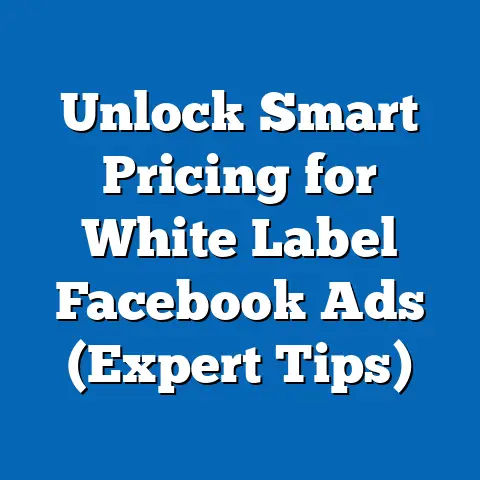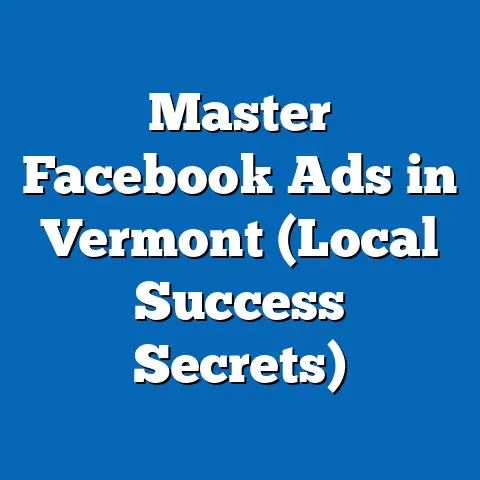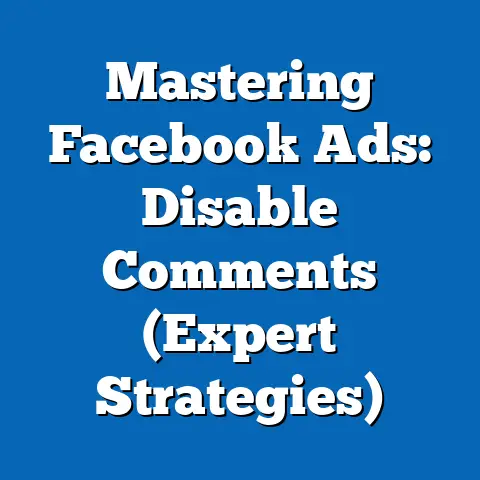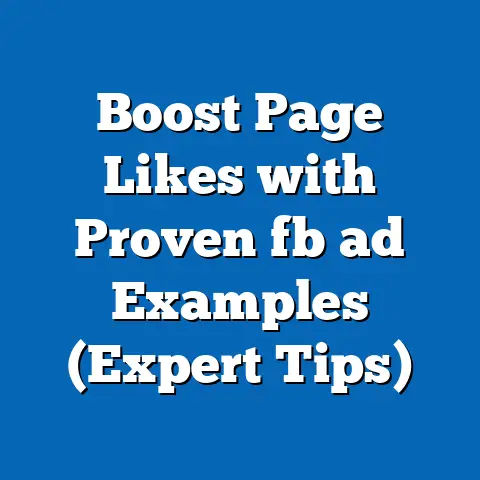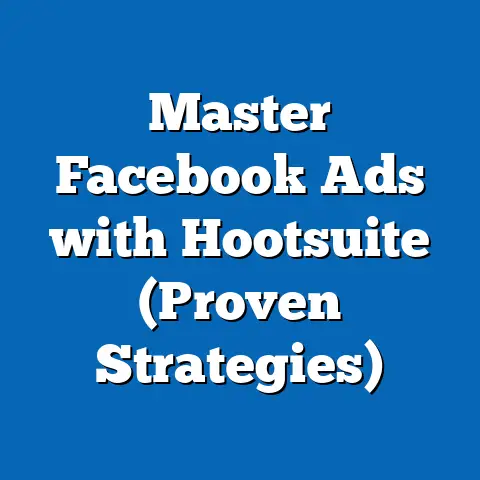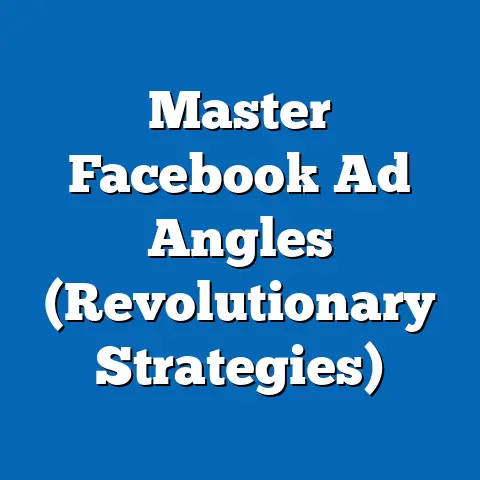Unlocking Facebook Ads CTR Secrets (Expert Insights)
In the whirlwind world of digital marketing, one thing remains constant: the need to adapt. We’re not just talking about tweaking a few settings here and there; we’re talking about a fundamental shift in how we approach our strategies. Facebook Ads, despite the ever-changing landscape of social media, continues to be a powerhouse for businesses of all sizes. But let’s be honest, simply throwing money at the platform and hoping for the best is a recipe for disaster. To truly succeed, you need to be a chameleon, adapting to new trends, algorithm updates, and, most importantly, the ever-evolving behaviors of your target audience.
One metric stands tall as a beacon of success (or a warning sign of failure) in the realm of Facebook Ads: the Click-Through Rate, or CTR. It’s more than just a number; it’s a window into the soul of your campaign, revealing whether your ads are resonating with the people you’re trying to reach. A high CTR means you’re doing something right. A low CTR? Well, that’s a call to action to overhaul your approach.
In this article, I’m going to pull back the curtain and share some expert insights, proven strategies, and actionable tips that will help you unlock the secrets to a higher CTR on your Facebook Ads. This isn’t just about vanity metrics; it’s about driving real results for your business. So, buckle up, because we’re about to dive deep into the world of Facebook Ads CTR and emerge with a roadmap to success.
Understanding Click-Through Rate (CTR)
Let’s start with the basics. What exactly is Click-Through Rate? Simply put, it’s the percentage of people who see your ad and actually click on it. It’s calculated by dividing the number of clicks your ad receives by the number of times it’s shown (impressions), then multiplying by 100 to get a percentage.
CTR = (Total Clicks / Total Impressions) x 100
For example, if your ad is shown 1,000 times and receives 20 clicks, your CTR would be 2%.
Why is CTR so important in Facebook advertising?
- Relevance Indicator: CTR is a direct reflection of how relevant your ad is to your target audience. A high CTR indicates that your ad copy, visuals, and offer are resonating with the people you’re trying to reach.
- Quality Score Factor: Facebook uses CTR as one of the factors in determining your ad’s quality score. A higher quality score can lead to lower advertising costs and better ad placement.
- Campaign Performance Predictor: CTR is a key indicator of overall campaign performance. A higher CTR often translates into more website traffic, leads, and sales.
- Budget Efficiency: Improving your CTR can help you get more bang for your buck. By attracting more clicks with the same budget, you can potentially increase your return on investment (ROI).
What constitutes a “good” CTR?
This is where things get a little tricky. There’s no one-size-fits-all answer to what a good CTR should be. It varies significantly depending on several factors, including:
- Industry: Some industries naturally have higher CTRs than others. For example, ads for consumer products often have higher CTRs than ads for financial services.
- Target Audience: The more specific and well-defined your target audience, the higher your CTR is likely to be.
- Ad Placement: Ads placed in the Facebook News Feed tend to have higher CTRs than ads placed in the right column.
- Ad Format: Video ads often have higher CTRs than image ads.
- Campaign Objective: If your campaign objective is brand awareness, a lower CTR might be acceptable. However, if your objective is driving sales, you’ll want a higher CTR.
General Benchmarks
While there’s no magic number, here are some general benchmarks to keep in mind:
- Average CTR Across All Industries: Around 1% is considered an average CTR.
- Good CTR: A CTR of 2% or higher is generally considered good.
- Excellent CTR: A CTR of 3% or higher is considered excellent and indicates that your ads are highly relevant and engaging.
Factors Influencing CTR
Several factors can influence your CTR, including:
- Ad Relevance: How well your ad matches the interests and needs of your target audience.
- Targeting: The accuracy and precision of your targeting.
- Ad Copy: The clarity, persuasiveness, and call to action of your ad copy.
- Visuals: The quality, relevance, and appeal of your ad images or videos.
- Ad Placement: Where your ad is shown on Facebook (e.g., News Feed, right column, Instagram).
- Ad Format: The type of ad you’re using (e.g., image ad, video ad, carousel ad).
- Offer: The value and attractiveness of your offer.
- Competition: The level of competition in your industry and target audience.
My Personal Experience
I once worked with a client in the e-commerce space who was struggling with a consistently low CTR of around 0.5%. After digging deeper, I realized their targeting was too broad, and their ad copy was generic and uninspired. By refining their targeting to focus on specific customer segments and crafting more compelling ad copy that highlighted the unique benefits of their products, we were able to increase their CTR to over 2% within a few weeks. This not only improved their ad performance but also significantly reduced their advertising costs.
Takeaway: Understanding CTR is crucial for evaluating the effectiveness of your Facebook Ads. By analyzing the factors that influence CTR and continuously monitoring your ad performance, you can optimize your campaigns to achieve better results.
Next Steps: Start by tracking your CTR for each of your Facebook Ads campaigns. Analyze the factors that are influencing your CTR and identify areas for improvement.
The Role of Targeting in CTR
Targeting is arguably one of the most crucial aspects of Facebook advertising, and it plays a significant role in determining your CTR. Think of it this way: you can have the most beautifully crafted ad copy and stunning visuals, but if you’re showing it to the wrong people, it’s like shouting into the void.
Facebook offers a plethora of targeting options, allowing you to reach specific segments of its vast user base. Let’s break down some of the most important ones:
- Demographics: This includes basic information like age, gender, location, education, job title, and relationship status. It’s a good starting point for narrowing down your audience.
- Interests: This targets users based on their expressed interests and hobbies, as indicated by the pages they like, the groups they join, and the topics they engage with on Facebook.
- Behaviors: This targets users based on their online and offline behaviors, such as purchase history, device usage, travel habits, and more.
- Custom Audiences: This allows you to upload your own data (e.g., email lists, phone numbers, website visitors) to create highly targeted audiences.
- Lookalike Audiences: This allows you to create audiences that are similar to your existing customers or website visitors. Facebook analyzes the characteristics of your source audience and identifies other users who share those same traits.
- Detailed Targeting Expansion: This is an option you can select that allows Facebook to expand your targeting if it thinks it will get you better results. Use this with caution, as it can sometimes lead to irrelevant traffic.
Understanding Your Target Audience
The key to effective targeting is understanding your target audience inside and out. You need to know:
- Who they are: What are their demographics, interests, and behaviors?
- What they need: What problems are they trying to solve? What are their pain points?
- Where they are: Where do they spend their time online? What websites do they visit? What social media platforms do they use?
- Why they buy: What motivates them to make a purchase? What are their values and beliefs?
Using Facebook’s Audience Insights Tool
Facebook’s Audience Insights tool is a goldmine of information that can help you refine your targeting strategies. This tool allows you to:
- Analyze the demographics, interests, and behaviors of your target audience.
- Discover the top pages, locations, and languages of your target audience.
- Identify potential new target audiences.
- Understand the purchase behavior of your target audience.
To access Audience Insights, go to Facebook Ads Manager, click on the “Tools” menu, and select “Audience Insights.” From there, you can choose to analyze everyone on Facebook or a specific custom audience.
My Personal Experience
I once worked with a local restaurant that was struggling to attract new customers. Their initial targeting was very broad, targeting everyone within a 10-mile radius of their location. Using Audience Insights, I discovered that their ideal customers were young professionals who were interested in healthy eating and supporting local businesses. By refining their targeting to focus on this specific audience, we were able to significantly increase their CTR and drive more foot traffic to their restaurant.
Targeting Tips
- Start with a broad audience and then narrow it down.
- Use multiple layers of targeting to reach a more specific audience.
- Test different targeting options to see what works best for your business.
- Use lookalike audiences to expand your reach to new potential customers.
- Regularly review and update your targeting to ensure it’s still relevant.
- Don’t be afraid to experiment with new targeting options.
- Exclude audiences that are not relevant to your business.
Takeaway: Targeting is a critical component of Facebook advertising success. By understanding your target audience and using Facebook’s targeting options effectively, you can significantly increase your CTR and drive better results.
Next Steps: Take some time to analyze your current targeting strategies. Are you reaching the right people? Are you using all of the targeting options available to you? Use Facebook’s Audience Insights tool to gain a deeper understanding of your target audience and identify areas for improvement.
Crafting Compelling Ad Copy
Let’s face it, even with the most laser-focused targeting, your ad can fall flat if the copy is uninspired. Think of your ad copy as the salesperson for your business. It’s the first (and sometimes only) chance you have to grab someone’s attention and convince them to take action.
The Anatomy of Compelling Ad Copy
- Headline: This is the most important part of your ad copy. It’s the first thing people will see, so it needs to be attention-grabbing and relevant.
- Description: This provides more details about your product or service and explains why people should click on your ad.
- Call to Action (CTA): This tells people what you want them to do (e.g., “Learn More,” “Shop Now,” “Sign Up”).
Tips for Writing Compelling Headlines
- Focus on the benefits: Explain how your product or service can solve your target audience’s problems or improve their lives.
- Use storytelling: Tell a story that resonates with your target audience and makes your product or service more relatable.
- Use social proof: Include testimonials, reviews, or case studies to build trust and credibility.
- Use humor: If appropriate for your brand, humor can make your ad more memorable and engaging.
- Keep it concise: People have short attention spans, so get to the point quickly.
Tips for Writing Effective Calls to Action
- Use strong action verbs: Use verbs like “Shop,” “Learn,” “Sign Up,” or “Download.”
- Be specific: Tell people exactly what you want them to do.
- Create a sense of urgency: Use words like “Now” or “Today” to encourage people to take action immediately.
- Make it visually appealing: Use a button or other visual element to make your CTA stand out.
- A/B test different CTAs: See which CTAs perform best for your target audience.
Examples of High-Performing Ad Copy
Let’s analyze a few examples of high-performing ad copy and see what makes them effective:
- Example 1: Shopify
- Headline: Start Your Free Trial Today
- Description: Build your online store with Shopify. No credit card required.
- CTA: Start Free Trial
- Analysis: This ad copy is clear, concise, and benefit-driven. It highlights the key benefit of Shopify (building an online store) and addresses a common concern (no credit card required).
- Example 2: Grammarly
- Headline: Great Writing, Simplified
- Description: Grammarly helps you eliminate errors and find the perfect words to express yourself.
- CTA: Get Grammarly
- Analysis: This ad copy is simple, yet powerful. It focuses on the value proposition of Grammarly (improving your writing) and uses strong keywords like “great writing” and “errors.”
- Example 3: Skillshare
- Headline: Unlock Your Creativity with Skillshare
- Description: Explore thousands of creative classes and learn new skills.
- CTA: Start Learning
- Analysis: This ad copy is aspirational and inspiring. It appeals to people’s desire to learn and grow and uses a strong call to action (“Start Learning”).
- Headline: Start Your Free Trial Today
- Description: Build your online store with Shopify. No credit card required.
- CTA: Start Free Trial
- Analysis: This ad copy is clear, concise, and benefit-driven. It highlights the key benefit of Shopify (building an online store) and addresses a common concern (no credit card required).
- Headline: Great Writing, Simplified
- Description: Grammarly helps you eliminate errors and find the perfect words to express yourself.
- CTA: Get Grammarly
- Analysis: This ad copy is simple, yet powerful. It focuses on the value proposition of Grammarly (improving your writing) and uses strong keywords like “great writing” and “errors.”
- Headline: Unlock Your Creativity with Skillshare
- Description: Explore thousands of creative classes and learn new skills.
- CTA: Start Learning
- Analysis: This ad copy is aspirational and inspiring. It appeals to people’s desire to learn and grow and uses a strong call to action (“Start Learning”).
My Personal Experience
I once worked with a clothing retailer that was struggling to generate sales through their Facebook Ads. Their ad copy was bland and generic, simply listing the products they were selling. By crafting more compelling ad copy that highlighted the unique style and quality of their clothing, and by using storytelling to connect with their target audience, we were able to significantly increase their CTR and drive more sales.
Ad Copy Tips
- Know your audience: Write ad copy that speaks directly to their needs and interests.
- Highlight benefits, not just features: Focus on what your product or service can do for your target audience.
- Use strong verbs and action words: Make your ad copy more persuasive and engaging.
- Keep it short and sweet: People have short attention spans, so get to the point quickly.
- A/B test different ad copy variations: See which ad copy performs best for your target audience.
- Use emojis sparingly: Emojis can add personality to your ad copy, but don’t overdo it.
- Proofread your ad copy carefully: Errors can damage your credibility.
Takeaway: Compelling ad copy is essential for driving CTR on Facebook Ads. By crafting headlines, descriptions, and calls to action that resonate with your target audience, you can significantly increase your ad performance and achieve better results.
Next Steps: Review your current ad copy. Is it compelling and engaging? Does it speak directly to your target audience? A/B test different ad copy variations to see what works best for your business.
The Impact of Visuals on CTR
In the visually-driven world of social media, your ad’s visual elements are often the first thing people notice. A captivating image or video can stop someone in their tracks and entice them to learn more, while a poorly chosen visual can send them scrolling right past your ad.
The Importance of Visuals
- First Impressions: Visuals create a first impression, and you only have a few seconds to make it count.
- Attention-Grabbing: Compelling visuals can grab attention and break through the clutter of the Facebook News Feed.
- Storytelling: Visuals can tell a story and connect with your target audience on an emotional level.
- Brand Recognition: Consistent use of visuals can help build brand recognition and awareness.
- Increased Engagement: High-quality visuals can increase engagement and encourage people to click on your ad.
Best Practices for Choosing Visuals
- Relevance: Choose visuals that are relevant to your product or service and your target audience.
- High Quality: Use high-resolution images and videos that are visually appealing.
- Eye-Catching: Choose visuals that are eye-catching and stand out from the crowd.
- Authenticity: Use authentic visuals that reflect your brand’s personality and values.
- Mobile-Friendly: Optimize your visuals for mobile devices.
Types of Visuals
- Images: Images are a simple and effective way to showcase your product or service.
- Videos: Videos are more engaging than images and can be used to tell a story or demonstrate how your product or service works.
- Carousels: Carousels allow you to showcase multiple images or videos in a single ad.
- Slideshows: Slideshows are a simple and affordable way to create video-like content.
- Collections: Collections are a visually immersive ad format that allows you to showcase a catalog of products.
Visual Tips
- Use bright colors: Bright colors can grab attention and make your ad stand out.
- Show people using your product or service: This can help people visualize themselves using your product or service.
- Use faces: Faces can create an emotional connection with your target audience.
- Use humor (if appropriate): Humor can make your ad more memorable and engaging.
- Use text sparingly: Don’t clutter your visuals with too much text.
- Use contrasting colors: Contrasting colors can make your text easier to read.
- Use a consistent visual style: This can help build brand recognition.
A/B Testing Visuals
A/B testing is a powerful technique for optimizing your ad performance and increasing CTR. By testing different visual variations, you can identify which visuals resonate best with your target audience.
How to A/B Test Visuals
- Create two or more variations of your ad with different visuals.
- Set up an A/B test in Facebook Ads Manager.
- Run the test for a sufficient amount of time (at least a few days).
- Analyze the results and identify the winning visual.
- Use the winning visual in your future ad campaigns.
My Personal Experience
I once worked with a travel agency that was using generic stock photos in their Facebook Ads. By replacing the stock photos with authentic photos of real travelers enjoying their vacations, we were able to significantly increase their CTR and drive more bookings.
Takeaway: Visuals play a crucial role in the success of your Facebook Ads. By choosing high-quality, relevant, and eye-catching visuals, you can significantly increase your CTR and drive better results.
Next Steps: Review the visuals you’re currently using in your Facebook Ads. Are they high-quality, relevant, and eye-catching? A/B test different visual variations to see what works best for your business.
Leveraging Facebook Ad Formats
Facebook offers a diverse array of ad formats, each designed to cater to different campaign objectives and audience preferences. Understanding the strengths and weaknesses of each format is essential for maximizing your CTR and overall campaign performance.
Overview of Different Facebook Ad Formats
- Image Ads: The simplest and most common ad format, featuring a single image and accompanying text.
- Strengths: Easy to create, versatile, and can be used for a variety of campaign objectives.
- Weaknesses: Can be less engaging than other formats, especially if the image is not compelling.
- Video Ads: More engaging than image ads, allowing you to tell a story or demonstrate your product in action.
- Strengths: Highly engaging, can convey complex information quickly, and can generate strong emotional connections.
- Weaknesses: Can be more expensive to produce than image ads, and requires careful planning and execution.
- Carousel Ads: Allows you to showcase multiple images or videos in a single ad, each with its own headline, description, and link.
- Strengths: Ideal for showcasing a product line, telling a story in multiple steps, or highlighting different features of a single product.
- Weaknesses: Requires more creative effort than single-image ads, and can be overwhelming if not designed well.
- Slideshow Ads: Creates a video-like experience using a series of still images, often with music or text overlays.
- Strengths: Affordable way to create engaging video content, easy to produce, and can be used to tell a simple story.
- Weaknesses: Can be less engaging than professionally produced videos, and may not be suitable for complex product demonstrations.
- Collection Ads: A visually immersive ad format that allows you to showcase a catalog of products in a mobile-friendly format.
- Strengths: Ideal for e-commerce businesses, allows users to browse products directly from the ad, and can drive high conversion rates.
- Weaknesses: Requires a product catalog and may not be suitable for all types of businesses.
- Instant Experience Ads (formerly Canvas Ads): Full-screen, mobile-optimized ads that load instantly and provide an immersive experience.
- Strengths: Highly engaging, allows you to tell a rich story, and can drive high conversion rates.
- Weaknesses: Requires more creative effort than other formats, and may not be suitable for all types of businesses.
- Lead Ads: Designed to collect leads directly from Facebook, without requiring users to visit your website.
- Strengths: Easy to collect leads, mobile-friendly, and can be integrated with your CRM system.
- Weaknesses: Lead quality can vary, and requires careful follow-up to convert leads into customers.
- Strengths: Easy to create, versatile, and can be used for a variety of campaign objectives.
- Weaknesses: Can be less engaging than other formats, especially if the image is not compelling.
- Strengths: Highly engaging, can convey complex information quickly, and can generate strong emotional connections.
- Weaknesses: Can be more expensive to produce than image ads, and requires careful planning and execution.
- Strengths: Ideal for showcasing a product line, telling a story in multiple steps, or highlighting different features of a single product.
- Weaknesses: Requires more creative effort than single-image ads, and can be overwhelming if not designed well.
- Strengths: Affordable way to create engaging video content, easy to produce, and can be used to tell a simple story.
- Weaknesses: Can be less engaging than professionally produced videos, and may not be suitable for complex product demonstrations.
- Strengths: Ideal for e-commerce businesses, allows users to browse products directly from the ad, and can drive high conversion rates.
- Weaknesses: Requires a product catalog and may not be suitable for all types of businesses.
- Strengths: Highly engaging, allows you to tell a rich story, and can drive high conversion rates.
- Weaknesses: Requires more creative effort than other formats, and may not be suitable for all types of businesses.
- Strengths: Easy to collect leads, mobile-friendly, and can be integrated with your CRM system.
- Weaknesses: Lead quality can vary, and requires careful follow-up to convert leads into customers.
Choosing the Right Format
The best ad format for your business will depend on your campaign goals, target audience, and budget. Here are some general guidelines:
- Brand Awareness: Video ads, slideshow ads, and instant experience ads are ideal for raising brand awareness and telling your brand story.
- Lead Generation: Lead ads are the most effective format for collecting leads directly from Facebook.
- Website Traffic: Image ads, video ads, and carousel ads can be used to drive traffic to your website.
- Sales: Collection ads and carousel ads are ideal for showcasing products and driving sales.
- Engagement: Video ads and instant experience ads are highly engaging and can generate likes, comments, and shares.
My Personal Experience
I once worked with a real estate agent who was struggling to generate leads through their Facebook Ads. They were using image ads that simply showcased the properties they were selling. By switching to carousel ads that highlighted the key features of each property, and by using lead ads to collect contact information from interested buyers, we were able to significantly increase their lead generation and drive more sales.
Format Tips
- Test different ad formats to see what works best for your business.
- Use high-quality visuals that are optimized for each ad format.
- Write compelling ad copy that highlights the benefits of your product or service.
- Use a clear call to action that tells people what you want them to do.
- Target your ads to the right audience.
- Monitor your ad performance and make adjustments as needed.
Takeaway: Choosing the right Facebook ad format is crucial for maximizing your CTR and overall campaign performance. By understanding the strengths and weaknesses of each format and aligning them with your campaign goals and audience preferences, you can significantly improve your results.
Next Steps: Review the ad formats you’re currently using in your Facebook Ads. Are they the most appropriate formats for your campaign goals and target audience? Experiment with different ad formats to see what works best for your business.
Analyzing and Optimizing Ad Performance
Creating a great ad is only half the battle. The real magic happens when you start analyzing your ad performance and making data-driven optimizations to improve your results. It’s a continuous cycle of testing, measuring, and refining.
The Importance of Tracking and Analyzing Ad Performance
- Identify What’s Working: Tracking your ad performance allows you to see what’s working and what’s not.
- Optimize Your Campaigns: By analyzing your data, you can identify areas for improvement and make adjustments to your campaigns.
- Increase Your ROI: Optimizing your campaigns can help you increase your return on investment (ROI).
- Stay Ahead of the Competition: Continuously monitoring your ad performance allows you to stay ahead of the competition.
- Make Data-Driven Decisions: Analyzing your data allows you to make informed decisions about your advertising strategy.
Key Metrics to Track
- CTR (Click-Through Rate): As we’ve discussed, this measures the percentage of people who click on your ad.
- CPC (Cost Per Click): This measures the average cost you pay each time someone clicks on your ad.
- CPM (Cost Per Mille): This measures the cost you pay for every 1,000 impressions of your ad.
- Conversion Rate: This measures the percentage of people who complete a desired action (e.g., purchase, sign-up) after clicking on your ad.
- Cost Per Conversion: This measures the average cost you pay for each conversion.
- Reach: This measures the number of unique people who saw your ad.
- Frequency: This measures the average number of times each person saw your ad.
- Relevance Score: This measures how relevant your ad is to your target audience.
Using Facebook Ads Manager to Monitor and Optimize Campaigns
Facebook Ads Manager is your command center for monitoring and optimizing your campaigns. It provides a wealth of data and tools that can help you improve your ad performance.
Key Features of Facebook Ads Manager
- Campaign Dashboard: Provides an overview of your campaign performance, including key metrics like CTR, CPC, CPM, and conversion rate.
- Ad Set Reporting: Allows you to analyze the performance of individual ad sets, including targeting, budget, and placement.
- Ad Reporting: Allows you to analyze the performance of individual ads, including ad copy, visuals, and call to action.
- A/B Testing: Allows you to test different ad variations to see what works best for your business.
- Audience Insights: Provides insights into the demographics, interests, and behaviors of your target audience.
- Attribution Modeling: Allows you to track the customer journey and attribute conversions to specific ads.
Optimization Strategies
- Improve Your Targeting: Refine your targeting to reach a more relevant audience.
- Optimize Your Ad Copy: Write compelling ad copy that highlights the benefits of your product or service.
- Use High-Quality Visuals: Choose visuals that are relevant, eye-catching, and optimized for mobile devices.
- Experiment with Different Ad Formats: Test different ad formats to see what works best for your business.
- A/B Test Your Ads: Test different ad variations to see what resonates best with your target audience.
- Adjust Your Bids: Optimize your bids to ensure you’re getting the most for your money.
- Monitor Your Ad Frequency: Keep your ad frequency in check to avoid ad fatigue.
- Use Retargeting: Retarget users who have previously interacted with your website or Facebook page.
- Analyze Your Data and Make Adjustments: Continuously monitor your ad performance and make adjustments based on your data.
My Personal Experience
I once worked with a fitness studio that was struggling to generate leads through their Facebook Ads. After analyzing their data, I discovered that their ads were being shown to people who were not interested in fitness. By refining their targeting to focus on people who were interested in health and wellness, and by using A/B testing to optimize their ad copy and visuals, we were able to significantly increase their lead generation and drive more memberships.
Takeaway: Analyzing and optimizing your ad performance is essential for maximizing your ROI on Facebook Ads. By tracking key metrics, using Facebook Ads Manager effectively, and implementing data-driven optimization strategies, you can significantly improve your results.
Next Steps: Start tracking your ad performance in Facebook Ads Manager. Analyze your data and identify areas for improvement. Implement optimization strategies based on your data and continuously monitor your ad performance.
Conclusion
Unlocking the secrets to a high CTR on Facebook Ads is not about finding a magic formula or a one-size-fits-all solution. It’s about embracing a mindset of adaptability, creativity, and continuous learning. The strategies and insights I’ve shared in this article are a starting point, but the real work begins when you start experimenting, analyzing, and refining your approach based on your own unique data and experiences.
The world of Facebook advertising is constantly evolving, with new features, algorithm updates, and audience behaviors emerging all the time. To stay ahead of the curve, you need to be a lifelong learner, always seeking new knowledge and insights.
Remember, a high CTR is not just about vanity metrics. It’s about driving real results for your business, whether that’s generating leads, increasing sales, or building brand awareness. By focusing on relevance, engagement, and optimization, you can unlock the power of Facebook Ads and achieve your business goals.
Key Takeaways:
- CTR is a critical metric for measuring the effectiveness of your Facebook Ads.
- Targeting plays a significant role in determining your CTR.
- Compelling ad copy is essential for driving clicks.
- Visuals create a first impression and can significantly impact your CTR.
- Choosing the right ad format is crucial for maximizing your results.
- Analyzing and optimizing your ad performance is essential for improving your ROI.
- Adaptability, creativity, and continuous learning are key to success in Facebook advertising.
Call to Action:
Now it’s your turn! I encourage you to take the strategies and insights I’ve shared in this article and implement them in your own Facebook Ads campaigns. Don’t be afraid to experiment, test new ideas, and learn from your mistakes.
I’d love to hear about your experiences with Facebook Ads. What strategies have worked well for you? What challenges have you faced? Share your thoughts and insights in the comments below. Let’s create a community of learning and improvement where we can all help each other succeed in the ever-evolving world of Facebook advertising.

